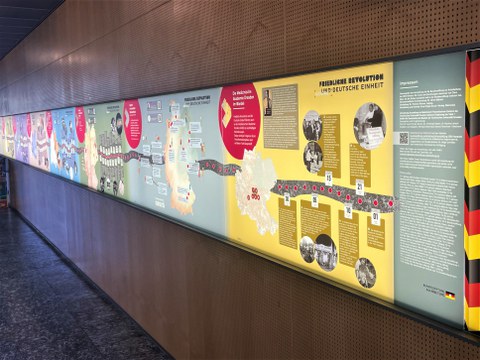Sep 16, 2025
Exhibition: Peaceful Revolution and German Unity

The exhibition is on display in MTZ until January 2026.
When the Swedish social physician Lennart Levi opened a congress at the Dresden Medical Academy on October 25, 1989, he spoke of the "encouraging" protests by citizens against the SED dictatorship, which he himself had experienced the day before on Theaterplatz. In his memoirs, he describes how some SED functionaries who attended the opening of the congress looked at him as if they wanted to "strangle" him.
This passage from Levi's autobiography is part of the exhibition "Peaceful Revolution and German Unity Compact", which the Institute of History of Medicine at TU Dresden is presenting in the Medical-Theoretical Center to mark the 35th anniversary of German reunification.
The exhibition organizes the Peaceful Revolution in the GDR and the unification process chronologically and geographically in compact presentations using maps and illustrated timelines. Important events on the way to the self-democratization of the GDR are shown - such as the removal of the leading role of the SED from the constitution in December 1989 or the first and only free elections to the People's Chamber in March 1990 - and their embedding in the upheavals in Eastern Europe and the world at that time. These include the demonstrations by hundreds of thousands of Baltic citizens for the independence of Estonia, Latvia and Lithuania from the Soviet Union in August 1989 and the bloody suppression of the Chinese opposition on Tiananmen Square in Beijing at the beginning of June 1989. The exhibition thus illustrates the simultaneity of the epochal upheaval of 1989/90 and its reciprocal influences.
These upheavals are complemented by an outline of important events at the Medical Academy in Dresden in the years of transformation from 1989 to 1993. These include, for example, the public protest against the conditions at Dresden's hospitals in 1990, the first free and secret election of a University Assembly of the Medical Academy and the introduction of clinical studies. With initial research into the significance and influence of the years of change on the Medical Academy, the Institute is thus offering a glimpse of university life in transition, a topic that will continue to be a focus of medical history research at the faculty in the future.
With the presentation in the Medical-Theoretical Center (MTZ), the exhibition "Peaceful Revolution and German Unity Compact" in a prominent location on campus invites visitors to recapitulate the epochal upheaval of 1989/1990 and reflect on how it affected the Dresden Medical Academy.
The exhibition will be on display in the MTZ until January 2026.
An exhibition by the Federal Foundation for the Reappraisal of the SED Dictatorship with texts and drawings by Clara Marz, from the Institute of History of Medicine at TU Dresden, supplemented by the content "Die Medizinische Akademie Dresden im Wandel".
Where: Foyer of the Medical-Theoretical Center
Medical Faculty of the TU Dresden
Fiedlerstraße 42
01307 Dresden
When: August 2025 to January 2026
